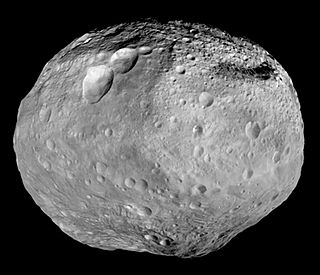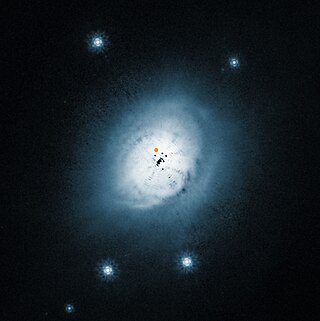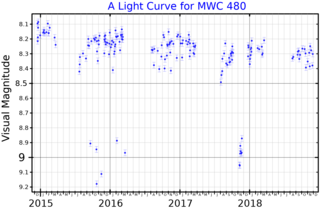
Fomalhaut is the brightest star in the southern constellation of Piscis Austrinus, the Southern Fish, and one of the brightest stars in the night sky. It has the Bayer designation Alpha Piscis Austrini, which is an alternative form of α Piscis Austrini, and is abbreviated Alpha PsA or α PsA. This is a class A star on the main sequence approximately 25 light-years (7.7 pc) from the Sun as measured by the Hipparcos astrometry satellite. Since 1943, the spectrum of this star has served as one of the stable anchor points by which other stars are classified.

A proplyd, short for ionized protoplanetary disk, is an externally illuminated photoevaporating protoplanetary disk around a young star. Nearly 180 proplyds have been discovered in the Orion Nebula. Images of proplyds in other star-forming regions are rare, while Orion is the only region with a large known sample due to its relative proximity to Earth.

A protoplanet is a large planetary embryo that originated within a protoplanetary disk and has undergone internal melting to produce a differentiated interior. Protoplanets are thought to form out of kilometer-sized planetesimals that gravitationally perturb each other's orbits and collide, gradually coalescing into the dominant planets.

TW Hydrae is a T Tauri star approximately 196 light-years away in the constellation of Hydra. TW Hydrae is about 80% of the mass of the Sun, but is only about 5-10 million years old. The star appears to be accreting from a protoplanetary disk of dust and gas, oriented face-on to Earth, which has been resolved in images from the ALMA observatory. TW Hydrae is accompanied by about twenty other low-mass stars with similar ages and spatial motions, comprising the "TW Hydrae association" or TWA, one of the closest regions of recent "fossil" star-formation to the Sun.

HD 100546, also known as KR Muscae, is a pre-main sequence star of spectral type B8 to A0 located 353 light-years from Earth in the southern constellation of Musca. The star is surrounded by a circumstellar disk from a distance of 0.2 to 4 AU, and again from 13 AU out to a few hundred AU, with evidence for a protoplanet forming at a distance of around 47 AU.

Zeta Doradus, Latinized from ζ Doradus, is a young star system that lies approximately 38 light-years away. The system consists of two widely separated stars, with the primary being bright enough to be observed with the naked eye but the secondary being much a much fainter star that requires telescopic equipment to be observed.
HD 97048 or CU Chamaeleontis is a Herbig Ae/Be star 603 ly away in the constellation Chamaeleon. It is a variable star embedded in a dust cloud containing a stellar nursery, and is itself surrounded by a dust disk.

V1094 Scorpii is a young stellar object in the constellation of Scorpius, located in the young Lupus Star Forming Region. It is being orbited by a protoplanetary disk that extends out to a distance of 300 AU from the host star. There are gaps at 100 AU and 170 AU, with bright rings at 130 AU and 220 AU.

27 Vulpeculae is a single, blue-white star in the northern constellation of Vulpecula. It is a dim star, visible to the naked eye, with an apparent visual magnitude of 5.59. An annual parallax shift of 10.6692±0.0483 mas provides a distance estimate of about 306 light-years. It is moving closer with a heliocentric radial velocity of −22 km/s, and will make perihelion passage at a distance of around 119 ly (36.56 pc) in 3.75 million years.

HD 142527 is a binary star system in the constellation of Lupus. The primary star belongs to the Herbig Ae/Be star class, while the companion, discovered in 2012, is a red dwarf star or accreting protoplanet with a projected separation of less than 0.1″. The system is notable for its circumbinary protoplanetary disk and its discovery has helped refine models of planet formation. The orbit of companion is strongly inclined to the circumbinary protoplanetary disk.

MWC 480 is a single star, about 500 light-years away in the constellation of Auriga. It is located in the Taurus-Auriga Star-Forming Region. The name refers to the Mount Wilson Catalog of B and A stars with bright hydrogen lines in their spectra. With an apparent magnitude of 7.62, it is too faint to be seen with the naked eye.

LkCa 15 is a T Tauri star in the Taurus Molecular Cloud. These types of stars are relatively young pre-main-sequence stars that show irregular variations in brightness. It has a mass that is about 97% of the Sun, an effective temperature of 4370 K, and is slightly cooler than the Sun. Its apparent magnitude is 11.91, meaning it is not visible to the naked eye.

GG Tauri, often abbreviated as GG Tau, is a quintuple star system in the constellation Taurus. At a distance of about 450 light years away, it is located within the Taurus-Auriga Star Forming Region. The system comprises three stars orbiting each other in a hierarchical triple system, known as GG Tauri A, and another binary star system more distant from the central system, known as GG Tauri B.

PDS 70 is a very young T Tauri star in the constellation Centaurus. Located 370 light-years from Earth, it has a mass of 0.76 M☉ and is approximately 5.4 million years old. The star has a protoplanetary disk containing two nascent exoplanets, named PDS 70b and PDS 70c, which have been directly imaged by the European Southern Observatory's Very Large Telescope. PDS 70b was the first confirmed protoplanet to be directly imaged.

CI Tauri is a young star, about 2 million years old, located approximately 523 light-years away in the constellation Taurus. It is still accreting material from a debris disk at an unsteady pace, possibly modulated by the eccentric orbital motion of an inner planet. The spectral signatures of compounds of sulfur were detected from the disk.

A circumplanetary disk is a torus, pancake or ring-shaped accumulation of matter composed of gas, dust, planetesimals, asteroids or collision fragments in orbit around a planet. They are reservoirs of material out of which moons may form. Such a disk can manifest itself in various ways.
HD 19467 is a star with an orbiting brown dwarf companion in the equatorial constellation of Eridanus. It has an apparent visual magnitude of 6.97, which is a challenge to view with the naked eye. The system is located at a distance of 104.5 light years based on parallax measurements, and is drifting further away with a radial velocity of 7 km/s. It has a high proper motion, traversing the celestial sphere at an angular rate of 0.258 arcsec yr−1. Based on the motion and chemical abundances of this star it has been considered a likely member of the Wolf 630 group of co-moving stars, although its age estimate is inconsistent with that assignment.

IRAS 23077+6707 is a protoplanetary disk seen edge-on. The disk blocks the light of the young star, causing the dark band in the middle. Dust particles scatter the light from the star, causing the bright nebula above and below the disk. The disk is 11 arcseconds in diameter and its distance is poorly constrained.



















